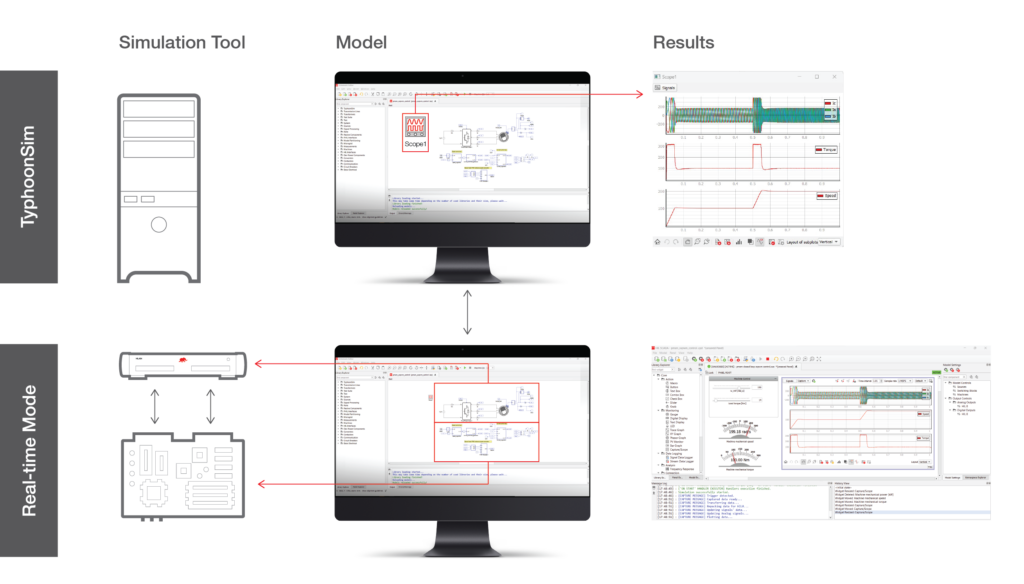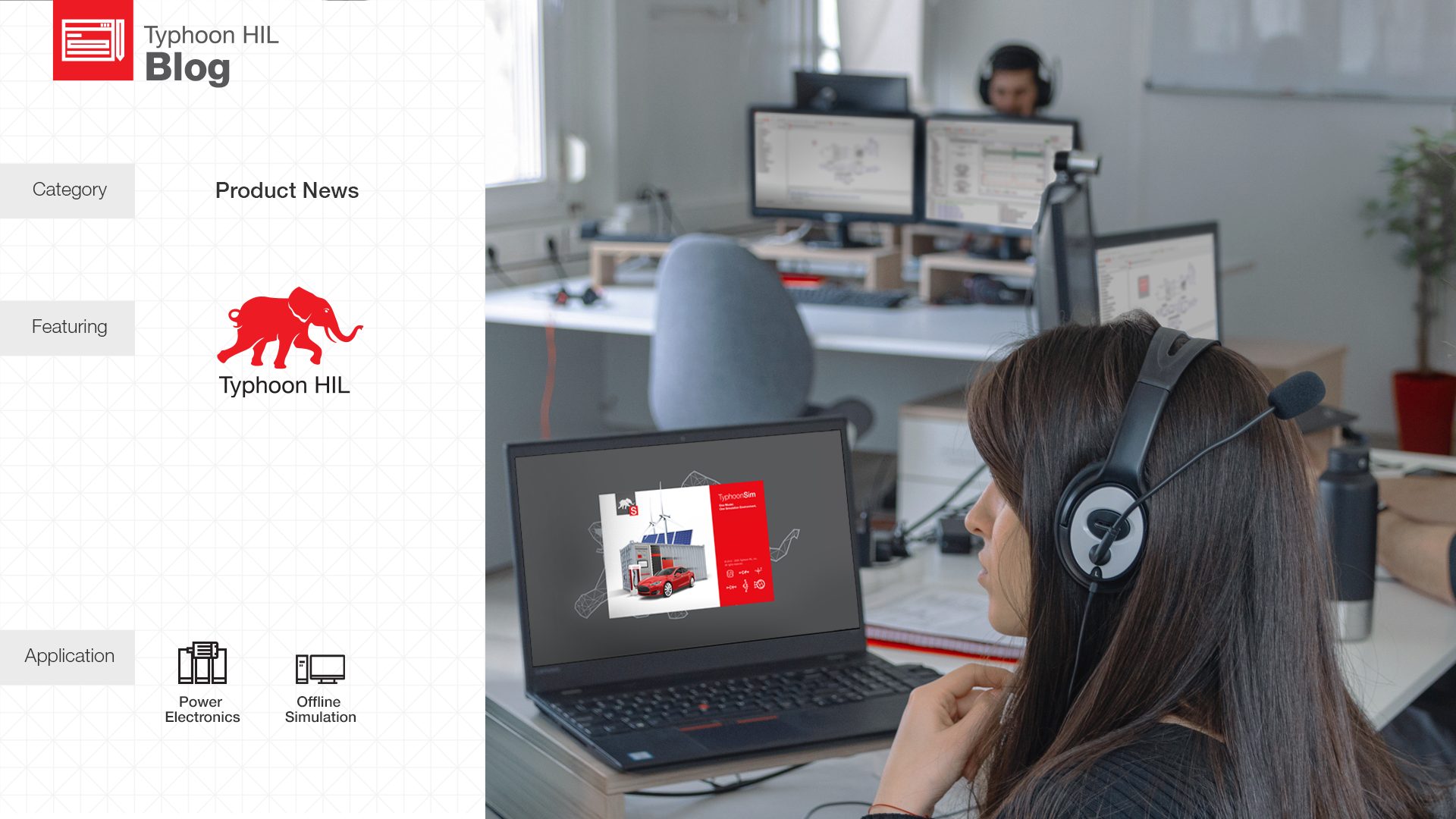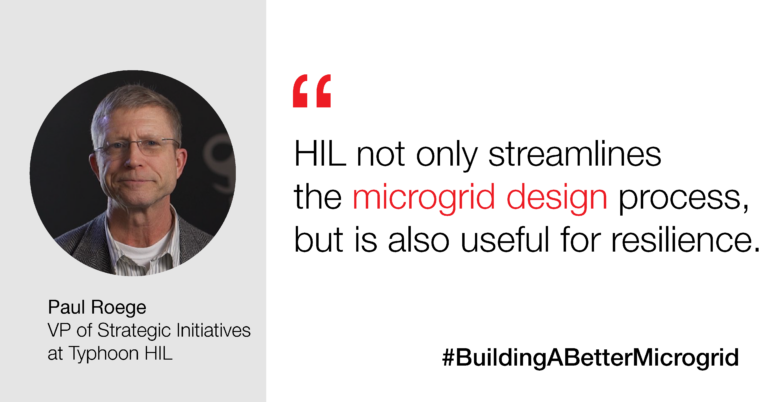Introduction to TyphoonSim
TyphoonSim is an offline simulator with high-speed, variable-step simulation capabilities, making it an essential tool for power stage and control design. Starting with the release of Typhoon HIL Control Center (THCC) 2024.4, TyphoonSim is fully integrated into the THCC toolchain, ensuring a smooth transition from offline simulation to real-time Hardware-in-the-Loop testing.
The full integration of TyphoonSim into the Typhoon HIL ecosystem makes truly agile power electronics control development easier than ever, coordinating updates across the entire development pipeline. This advancement enables professionals and academics alike to focus on what matters most—developing reliable, efficient, and sustainable power technologies for the future, without losing time re-drawing their schematics or switching between tools.
A Unified Toolchain for Design and Testing
Typhoon HIL’s integration of TyphoonSim into THCC is a game-changer for engineers. It creates a unified toolchain that eliminates the inefficiencies of transferring or redrawing schematics across platforms. Now, engineers can seamlessly transition from offline simulation to Software-in-the-Loop (SIL) and Hardware-in-the-Loop (HIL) testing, streamlining the entire design and validation process.

TyphoonSim enhances the development cycle by unifying these stages, providing high-speed, flexible offline simulation for early design phases. With both offline and real-time simulation libraries based on the same components, users can move from one phase to the next smoothly. The same model file can be used in both offline (top of Fig. 1) and real-time simulations (bottom of Fig. 1), allowing engineers to validate their models with just a click.
This streamlined toolchain cuts down on repetitive tasks, such as redrawing schematics, so engineers can spend more time focusing on what matters—developing their products. Typhoon HIL’s unified solution ensures efficiency, precision, and simplicity at every stage of the process.
Enhanced Component Setup and User Experience
A key benefit of TyphoonSim’s integration into THCC is the enhanced visibility and accessibility of components and features within the Schematic Editor. All library components are now displayed for every user, regardless of licensing status, allowing engineers to explore potential capabilities before obtaining licence access for a certain component or feature. Additionally, these components can be used for Virtual HIL (VHIL) simulations when applicable. For instance, if a component requires a toolbox not included in the device license for real-time simulation, it remains accessible for VHIL simulation. This allows users to experiment and evaluate features before deciding to extend their license.
Visual notifications, such as icons and tooltips, now indicate component requirements and provide guidance for configuration or license adjustments. For example, while browsing the Machines library, an engineer might see a machine marked with an icon indicating its unavailability in the real-time context due to missing device configurations. This occurs if the selected HIL device configuration does not support machine simulation. A quick adjustment in the Model Settings resolves this, instantly updating the component’s availability.
This dynamic interaction between configuration settings and component accessibility eliminates repetitive trial-and-error, significantly streamlining the model creation process. Watch the TyphoonSim demo video below to see it in action.
From Offline to Real-Time Simulation and Back with Ease
The new model visualization features in THCC enhance the user experience by allowing engineers to visualize entire models based on simulation context requirements. Using color-coded legends, components are easily identified as supported, unsupported, or ignored for offline and real-time/VHIL simulation. This feature is particularly valuable when working with inherited models, providing a quick and clear understanding of the requirements for successful simulation.
The Schematic Editor now includes perspectives, enabling users to choose between Integrated, Real-time, or TyphoonSim views. Each perspective customizes the interface to display notifications relevant to a specific simulation context, removing unnecessary components and properties to reduce visual clutter. The Real-time perspective optimizes the editor for real-time/VHIL model development, while TyphoonSim focuses on offline simulation. The Integrated perspective combines both, supporting workflows that involve both simulation contexts. This update ensures engineers see only the information relevant to their current tasks, improving efficiency and minimizing errors. More details are available in the documentation.
In addition to these workflow enhancements, TyphoonSim continues to excel in offline simulation scenarios, offering precision and flexibility that complement the real-time simulation capabilities of Typhoon HIL simulators. Together, these tools provide engineers with an integrated simulation environment capable of addressing challenges from early design stages to final system validation—all within a single model.
A Milestone in Simulation Technology
The full integration of TyphoonSim into the Typhoon HIL Control Center toolchain empowers power electronics and power systems engineers to achieve greater time and resource efficiency. By eliminating the need to redraw schematics or switch between tools, engineers can focus on developing reliable, efficient, and sustainable power technologies. This streamlined workflow accelerates research, fosters innovation and collaboration, and enables faster realization of valuable insights and solutions.
To maximize the potential of TyphoonSim and the entire Typhoon HIL toolchain, engineers are encouraged to explore the learning resources at HIL Academy. These programs and courses that cover real-time simulation and control design, equip participants with the skills to fully leverage TyphoonSim’s capabilities. The seamless integration of offline and real-time simulation not only optimizes project timelines but also enhances accuracy and confidence in system performance, enabling engineers to meet the demands of modern power systems with precision and efficiency.
Additional Resources
Credits
Author | Debora Santo, Milos Miletic
Visuals | Karl Mickei, Milica Obradovic
Technical Editor | Milos Miletic, Sergio Costa, Nikola Lucic
Blog Editor | Debora Santo, Dovlyn Curtis



